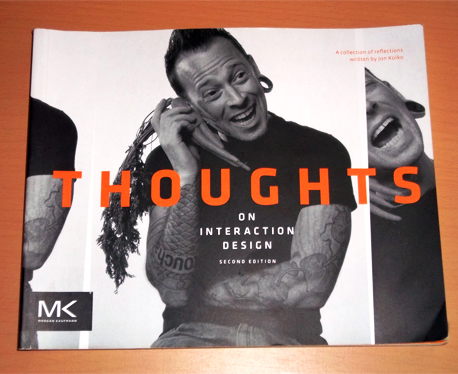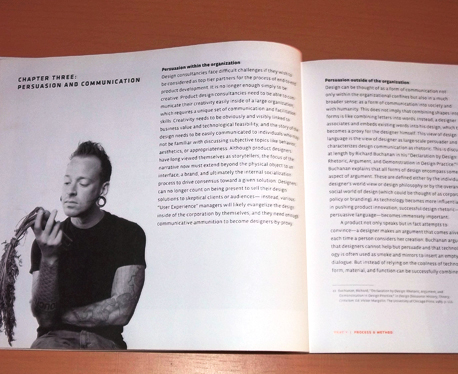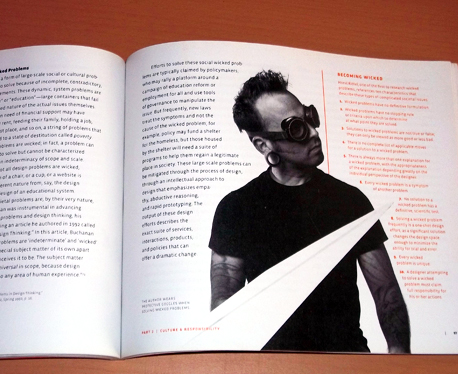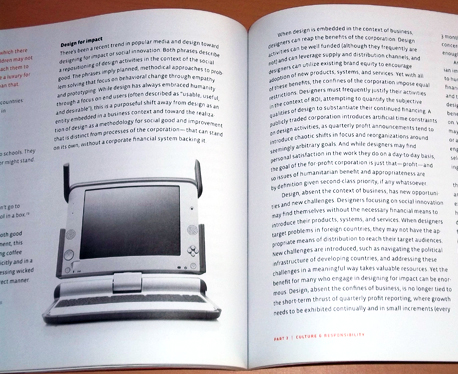Thoughts on Interaction Design, Second Edition
How often do you read a design text that impacts your life dramatically? As someone relatively new to the field of Interaction Design, John Kolko’s Thoughts on Interaction Design, Second Edition has allowed me to understand so much about the way I think, and the approach I’ve taken towards designing over the years. It’s content has shed light on many thoughts and ideas I’ve contemplated at one point or another, regarding design and its role in many aspects of human life. Although I have only really been exposed in interaction design for three years – there’s no institution in Jamaica that formally teaches interaction design – Kolko’s book made me realize I have been thinking like one for longer.
Now in its second edition, Kolko’s best-selling title builds upon its engaging material aimed to educate designers, help designers educate business owners, and legitimize Interaction Design for businesses, through contemplation and contribution to the theory of Interaction Design. Instead of focusing on the nature of design as related to the creation of two-, three-, or four-dimensional forms; or the nature of design as related to user interface design on a screen, this text primarily explores the semantic connections that live between technology and form that are brought to life when someone uses a product. It re-frames these connections as interactions – interactions that, in aggregate, make up behaviour.
In Thoughts on Interaction Design, the primary aims of the author are to better explain what Interaction Design is, and why it is important; to provide Interaction Designers with the vocabulary that is necessary to intellectualize their work and communicate it to others; and finally, to highlight the potential for Interaction Design to exist outside of the confines of business and to assure fellow Interaction Designers that their work is instrumental in shaping and refining culture- and is as instrumental as other intellectually robust fields, like medicine, policy, or law.
As Kolko says:
“We need to possess a great intellectual capacity for complicated problem solving, for dynamic inquiry relating to technology, and for substantial empathy of the human experience. This intellectual insight is ideal for solving the different societal problems plaguing humanity and for humanizing technology, and the creation of pretty interfaces is perhaps the most blatant (and unfortunately prevalent) misuse of this critical resource.”
The reader should not expect to find descriptions of specific methods that may be immediately applicable to his or her work, or ways to code interactive simulations. Kolko argues that other texts have covered these topics well enough and has chosen to focus mainly on describing Interaction Design through consideration and reflection on the more theoretical and conceptual aspects of the discipline.
The book consists of 128 pages, separated into two main parts: “Process and Method,” and “Culture and Responsibility.” These sections are broken down into different topics, each topic being represented by a specific chapter, amounting to a total of seven chapters - but begins with an overview which seeks to explain the role of technology, define Interaction Design as a professional discipline, as well as to shed some light on its role in the shaping of behaviour.
“Interaction Design is the creation of a dialogue between a person and a product, system, or service. This dialogue is both physical and emotional in nature and is manifested in the interplay between form, function, and technology as experienced over time.
A simpler way of thinking about Interaction Designers is that they are shapers of behaviour. Interaction Designers, whether practising as Usability Engineers, Visual Interface Designers, or Information Architects, all attempt to understand and alter the things people do, the way they feel, and the things they think.”
Chapter one, entitled “Thinking About People” positions Interaction Design as a creative process that focuses on people, and delineates the discrete steps that are usually taken when developing a cohesive Interaction Design. The process of design is explored through its different stages: Defining the design problem or opportunity; Discovering hidden wants, needs, and desires; Contextual Inquiry in the context of work; Focus groups and competitive analysis; Synthesis, creation and refinement; and Thoughtful reflection. In this chapter, Kolko also explains the role of intuition as well as the role of Design in considering the whole.
Chapter two, entitled “Managing Complexity” focuses on methods that can be used by a designer to gain deeper understanding of the abstract and semantic connections between ideas. This chapter focuses on: Structuring data in order to make useful information; the definition of Data, Information, Knowledge, and Wisdom; Designing with the fourth dimension (time) in mind; Affinity Diagrams, Concept Maps, Process Flow Diagrams, Ecosystem Diagrams as well as Journey Maps.
Chapter three, “Persuasion and Communication” explores issues relating to persuasion both within and outside of an organization; the role that designed artifacts play in identifying an underlying culture; as well as the ethics of persuasion.
Chapter four speaks to “Experience and Authenticity” while exploring the shift of viewing a product from an artifact to that of an experience; the challenges of experience, pragmatic challenges, owning the experience, authenticity, and temporal aesthetics in experiences.
Chapter five, entitled “Poetry, Spirit, and Soul” talks about honest interactions, investigating mindfulness, as well as attention to detail.
Chapter six, “Judgement and Shifting Negative Behaviour” explores topics such as: Usability and Influence, Discursive Design, What we choose to design, and Shifting negative behaviour through design.
Chapter seven, entitled “Wicked Problems” is the chapter that I found most intriguing, as here, Kolko explains that we as designers can successfully work on complicated, multifaceted problems related to social, political, or economic stability with the same set of tools used to solve more simplistic problems of form, style, or brand.
In this chapter, as well as all throughout the text, Kolko solidifies his arguments by referencing quotes and examples by thought leaders, practitioners and other authors, such as Richard Buchanan, who have been instrumental in advancing the discourse of wicked problems and design thinking. This, for example, is Richard Buchanan’s definition of wicked problems:
“Design problems are ‘indeterminate’ and ‘wicked’ because design has no special subject matter of its own apart from what a designer conceives it to be. The subject matter of design is potentially universal in scope, because design thinking may be applied to any area of human experience.”
Expanding on Buchanan, Kolko describes wicked problems as a form of large scale social or cultural problem that is difficult to solve because of incomplete, contradictory, and changing requirements. He cites the problems of poverty and education as wicked problems, and argues that these large scale problems can be mitigated through the process of design.
Other themes explored in this chapter include the related discipline of Service Design as well as Designing for Impact or Social Innovation.
I would recommend this book to anyone interested in the field Interaction Design, both for novices as well as seasoned practitioners. It contains many fascinating insights that will inspire any Interaction Designer, as well as better enable them to efficiently communicate and defend their role and importance. I will leave you with one such insight expressed by Jon Kolko himself:
“It is now time to extract design from the confines of business and allow it to grow on its own. Positioned as social entrepreneurship, social innovation, or the new design, designers are fundamental in structuring a world worth living in. Human behaviour is innately poetic; it is natural and thus resonates poetic in the same way as does a flower, or a bird, or a tree. It is through our own design of objects, services, and systems that we may have disturbed the poetry. A focus on technology or aesthetics alone creates a world of ideas that often seems discretely disconnected from humanity. Through the combination of technology, aesthetics, and humanity, we will find a world of Interaction Design.
And Interaction Design, as the study of dialogue between people and things, will bring harmony to technological advancement.”
Thoughts on Interaction Design, Second Edition is published by Morgan Kaufmann and is available from Amazon (US|CA|UK|DE).
About the Reviewer Roger Davis is a User Experience Designer from Kingston, Jamaica. He tweets at @layerphase






